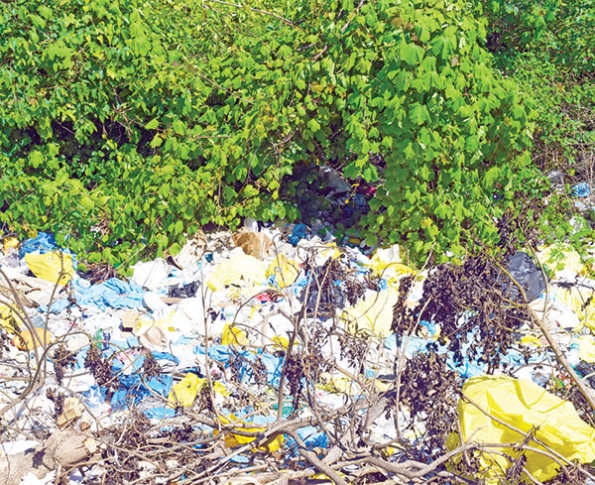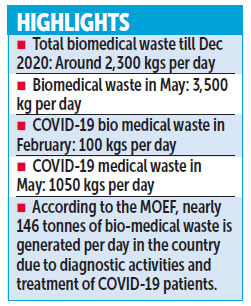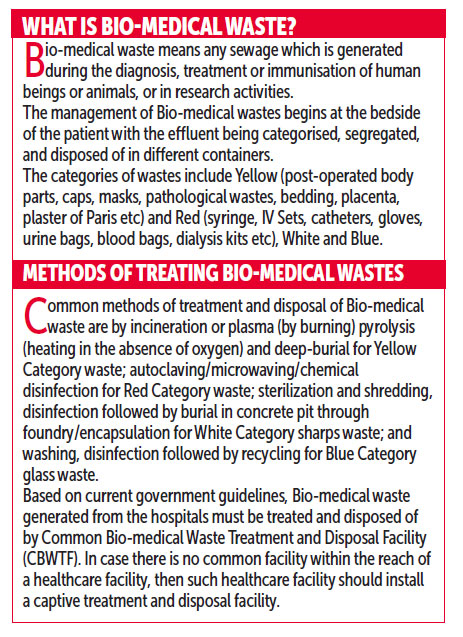
SHWETA KAMAT
The quantity of Bio-medical waste generated per day in Goa has witnessed a 50 per cent rise. From 2300 kgs per day till December 2020 to 3500 kgs per day till May end. The bio-medical waste related to COVID-19 which was around 100 kg per day till February, touched over 1050 kg per day in May.
Even though the hospitals and COVID-19 care centres are bound with protocols, laid down by the Pollution Authorities, when it comes to waste segregation, the unscientific disposal of COVID-19 biomedical remains worrisome. In the absence of common treatment facility most of it is left untreated with hospitals and local bodies found burning them in open spaces or dumping it in forest areas or throwing in rivers/water bodies.

COVID-19 biomedical waste could include PPE kits, masks, shoe covers, gloves, human tissues, items contaminated with blood, body fluids like dressings, plaster casts, cotton swabs, beddings contaminated with blood or body fluid, blood bags, needles, syringes, etc.
“In the absence of an appropriate and comprehensive bio-medical waste management system, including a treatment facility, there lies a risk of dumping bio-medical waste, open burning and disposal of the same with the municipal waste, which poses a serious health concern,” the Goa Waste Management Corporation (GWMC) said in its report released in February, this year.

A research article published in Heliyon scientific journal cautioned that greater generation of biomedical waste is inevitable during the pandemic outbreak, and its safe handling, treatment and disposal of waste must be prioritised for minimising contamination of land, water and air.
As per the Bio-Medical Waste Management Rules 2016, all hospitals are required to put in place a mechanism to effectively dispose of waste either directly or via common biomedical waste treatment and disposal facilities.
The GWMC Managing Director, Levinson Martins, said that the Corporation is in no position to collect, handle and treat the bio-medical waste in the absence of Common Bio-Medical Waste Treatment Facility (CBMWTF). “The facility, proposed at Kundaim is yet to be made operational. We expect the same to start by this month end. But till then, it is for the respective hospitals to handle the waste,” he said.
Currently, part of the bio-medical waste generated is disposed of by healthcare institutions by adopting the deep burial pit method. Recyclable treated waste is disposed after pre-treatment to recyclers, some is picked by local municipalities, and a large proportion is incinerated at Goa Medical College’s (GMC) facility. However, the incinerator with a capacity of only 100 kg per day finds it difficult to handle over 1000 kg of waste that comes from various hospitals, at its site.
Tonnes of bio-medical waste is seen dumped within the premise of the Goa Medical College and Hospital (GMC). As per information, waste from across the hospital, which runs into 1000 kg per day, is dumped at the site for treatment. However, on many instances, the waste is set on fire in a bid to discard it, thus causing severe air pollution in the vicinity.
A doctor at GMC explains “to control the spread of the virus, face mask is used as primary personal protective equipment (PPE) and hence its production and usage continue to rise. Further, most of these masks contain plastics or other derivatives of plastic thus generating tonnes of plastic wastes to the environment in a short span of time. Unscientific disposal of the same is leading to severe health hazard.”
According to the doctor, Bio-medical wastes are rising daily after the second COVID wave. “The rise in the number of beds, along with the increase in occupancy rate, has also contributed to the increase in the number of Bio-medical wastes,” doctor said adding that the occupancy level has increased from 50-60 per cent before COVID to almost 90-100 per cent now.
The total number of beds, before COVID-19, which were around 5000, increased manifold, including the 400-bedded, each two new facilities - South Goa District Hospital and Super Specialty block at Bambolim.
A senior official at the Environment department says that there is an immediate threat of unsafe disposal of healthcare waste that may create an environmental crisis. “Unsafe disposal of healthcare waste not only pollutes the environment but also poses a risk of infectious diseases,” official said adding ‘there have been complaints of bio-medical waste being dumped in some water bodies, or burnt in open spaces…this is worrying… the COVID-19 pandemic, seems to leave behind life-long environmental disaster, if not taken care now’.
The Goa State Pollution Control Board (GSPCB) member secretary Shamila Monteiro confirmed about complaints being received with regards to dumping of COVID waste at Nessai Industrial Estate and also in Chicalim Nullah. “Dumping or disposal of bio-medical waste in open or in water bodies leads to pollution and contamination, which is dangerous for Marine life, too,” she said.
